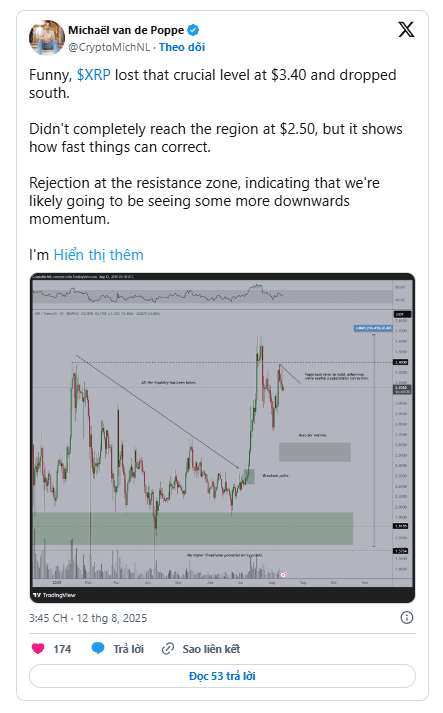XRP has dropped over 4% in the past 24 hours as the price faced rejection after failing to reach $3.50 amid potential risks of forming a bearish trap. The coin has lost the important support threshold of $3.40 as holders took profits, and large buyers did not intervene to stop the decline.
XRP Faces Difficulties After Losing Support Level of $3.40
Michaël van de Poppe, a leading cryptocurrency analyst, has shared his insights on the price outlook of XRP and the important price levels that investors should be aware of. He notes that with XRP unable to find support at the $3.40 level, pessimistic sentiment may emerge.
Notably, he predicts that this downturn could lead the asset to plunge to the $2.50 range, where it has strong support. However, XRP has managed to slow down the decline. Nevertheless, this development indicates that price volatility could decrease rapidly after losing the support threshold.

Michaël van de Poppe believes that this asset may face stronger resistance at this level, which could affect the price outlook.
"The rejection at the resistance zone suggests we may witness further declines," he wrote.
Note that XRP may have a very challenging journey within the $3 range. This is due to a large profit-taking event occurring at around $3.60. The technical barrier posed by this will require deliberate effort from bullish speculators in the ecosystem to break. The key support levels of XRP that buyers need to pay attention to.
The Key Support Levels of XRP That Buyers Need to Pay Attention To
Interestingly, van de Poppe hinted that he would wait until the price reaches between $2.40 and $2.60 before starting to buy.
He aims to buy lower at this level, while the breakout range above will be when the price hits $3.40 and finds stability. As of the time of writing, the price of XRP is trading at $3.11, down 4.41% in the past 24 hours.
Its daily high was $3.26 before a sharp decline due to market volatility and Bitcoin's dominance. However, trading volume remains positive and increased by 31.23% to $8.44 billion.
